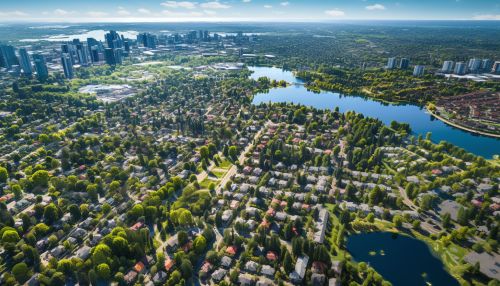Land use planning
Introduction
Land use planning is a technical and political process employed by public authorities to influence the distribution of people and activities in spaces of various scales. This process involves the systematic assessment of physical, social, and economic factors in such areas as to encourage and assist orderly, efficient, and sustainable development.
History
The history of land use planning is as old as human settlement itself. Early civilizations implemented rudimentary planning principles to control the chaos of rapid urbanization and to ensure the community's needs were met. The concept of land use planning evolved over time, with notable advancements during the Industrial Revolution and the 20th century.
Principles of Land Use Planning
Land use planning principles provide a basis for the systematic organization of land use and its impacts on the environment. These principles include the preservation of natural resources, the promotion of sustainable development, and the consideration of community needs and aspirations.
Preservation of Natural Resources
One of the primary principles of land use planning is the preservation of natural resources. This principle emphasizes the importance of protecting and conserving natural resources such as water, soil, minerals, and wildlife habitats. Land use planning aims to minimize the adverse effects of human activities on these resources.
Promotion of Sustainable Development
Another key principle of land use planning is the promotion of sustainable development. This principle underscores the need for development that meets the needs of the present without compromising the ability of future generations to meet their own needs. Land use planning seeks to balance economic development with environmental protection and social equity.
Consideration of Community Needs and Aspirations
The consideration of community needs and aspirations is also a fundamental principle of land use planning. This principle recognizes that land use decisions should reflect the values, needs, and desires of the community. Land use planning involves extensive public participation to ensure that the community's voice is heard and considered in the planning process.
Land Use Planning Process
The land use planning process involves several steps, including the identification of issues and goals, the collection and analysis of data, the development of a land use plan, and the implementation and monitoring of the plan.
Identification of Issues and Goals
The first step in the land use planning process is the identification of issues and goals. This involves determining the key issues that the plan needs to address and establishing the goals that the plan aims to achieve. This step often involves extensive public consultation to ensure that the plan reflects the community's needs and aspirations.
Collection and Analysis of Data
The next step in the land use planning process is the collection and analysis of data. This involves gathering information about the physical, social, and economic characteristics of the area. The data is then analyzed to identify trends, opportunities, and constraints that may affect the plan.
Development of a Land Use Plan
The development of a land use plan is the next step in the process. This involves creating a detailed plan that outlines how the land should be used, including the location of residential, commercial, industrial, and recreational areas. The plan also includes strategies for managing natural resources and promoting sustainable development.
Implementation and Monitoring of the Plan
The final step in the land use planning process is the implementation and monitoring of the plan. This involves putting the plan into action and regularly monitoring its progress to ensure that it is achieving its goals. This step also involves making adjustments to the plan as necessary to respond to changing conditions or unforeseen circumstances.
Challenges in Land Use Planning
Land use planning faces several challenges, including conflicting land uses, changing demographics, and climate change.
Conflicting Land Uses
One of the main challenges in land use planning is managing conflicting land uses. This involves balancing the needs of different land users and resolving disputes over land use. This challenge is often exacerbated in urban areas, where space is limited and demand for land is high.
Changing Demographics
Changing demographics also pose a challenge to land use planning. This involves adapting to changes in population size, age structure, and lifestyle preferences. These changes can have significant impacts on land use patterns and demand for services and infrastructure.
Climate Change
Climate change is another significant challenge for land use planning. This involves planning for the impacts of climate change, including sea-level rise, increased frequency and intensity of storms, and changes in temperature and precipitation patterns. Land use planning plays a critical role in mitigating the impacts of climate change and promoting climate resilience.
Conclusion
Land use planning is a complex and dynamic process that plays a crucial role in shaping the physical, social, and economic landscape of communities. Despite the challenges, effective land use planning can promote sustainable development, protect natural resources, and enhance the quality of life for all community members.
See Also


